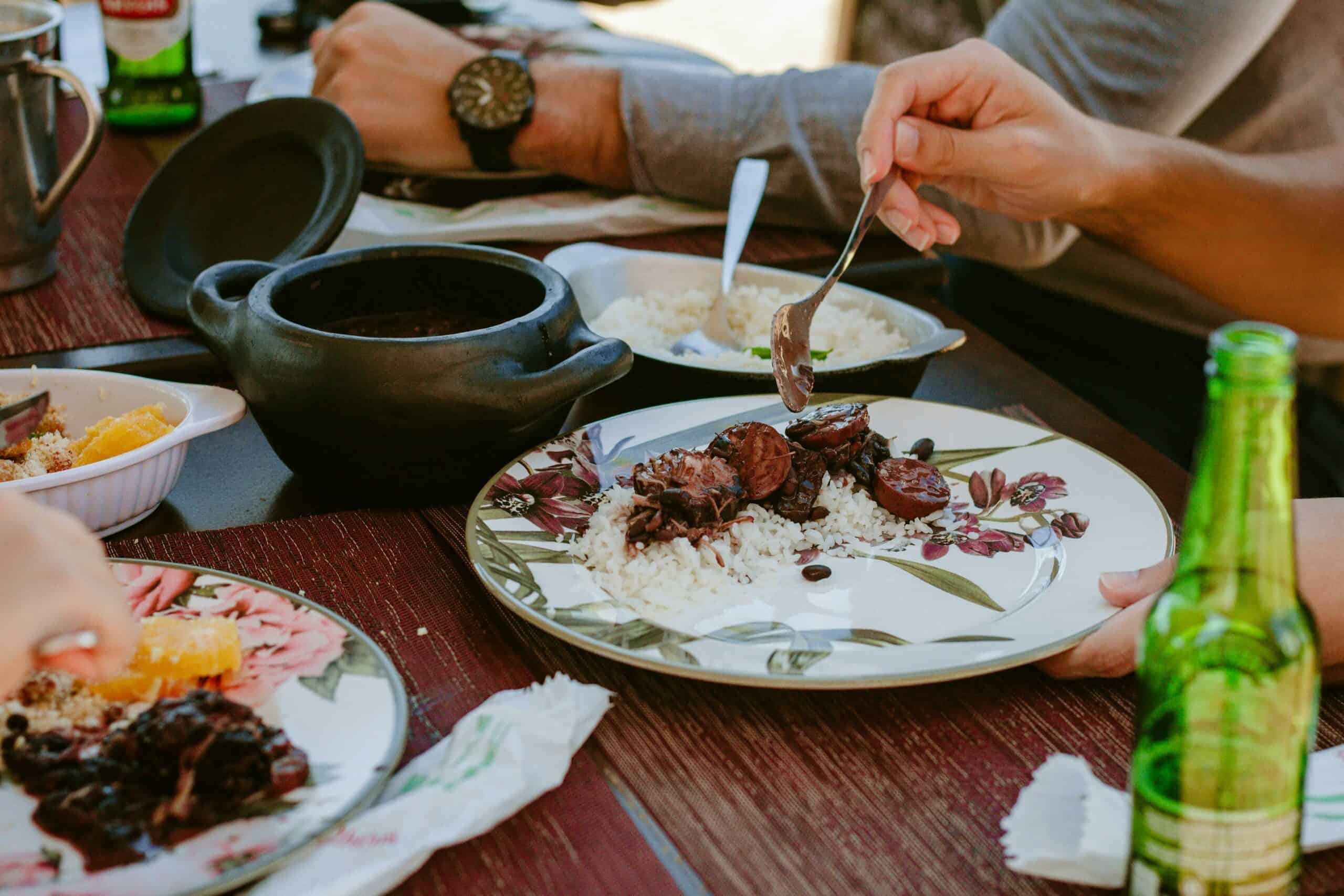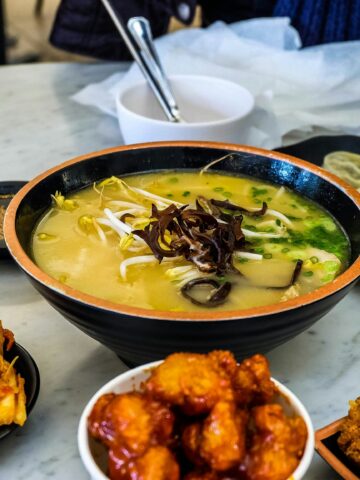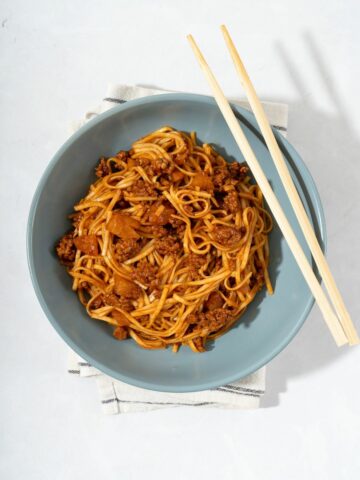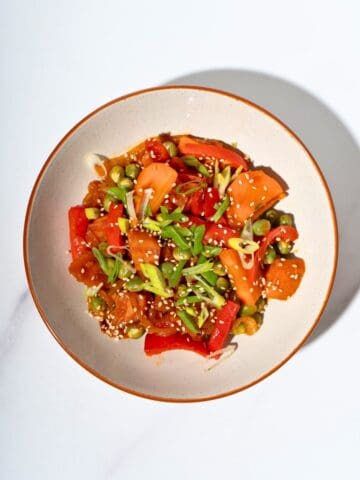Soondae is a beloved street food in South Korea known for its unique flavor and texture. A type of blood sausage, it’s made by steaming cow or pig intestines filled with various ingredients like glass noodles, rice, and vegetables. While it's popular in North and South Korea, its delicious taste has gained attention worldwide.
What makes soondae stand out is its versatility and nutritional value. This Korean blood sausage is high in carbohydrates and has a moderate amount of protein, making it a filling and satisfying snack. Surprisingly, it’s also low in fat, which adds to its appeal for those looking for a healthier option among street foods.
Whether you're exploring the bustling streets of Seoul or simply curious about international cuisine, trying soondae is a must. From its chewy texture to its rich, savory flavor, soondae offers a taste experience like no other.

Jump to:
⌛ Historical Background
Origin and Evolution
Soondae traces back to the Goryeo Period when it first appeared in Korean culinary records. Initially, it was a luxury item served at special banquets and ceremonies. During this time, the recipe included intestines stuffed with minced meats and vegetables.
As time progressed, soondae became more accessible to the general public. In modern days, it's commonly made with pork blood, glass noodles, and various grains. The ingredients and preparation methods have evolved, reflecting regional preferences in both South Korea and North Korea.
This transition from a royal delicacy to popular street food showcases its journey through Korea's history.
Cultural Significance
Soondae holds a special place in Korean culture. It’s commonly found in street markets and is a popular comfort food among locals. During historical events and family gatherings, soondae was often a highlight, symbolizing community and tradition.
Today, it remains deeply embedded in both North and South Korean societies. It’s not just eaten for its taste but also for its cultural resonance. The presence of soondae in various cultural events highlights its importance in Korean heritage. In essence, it acts as a bridge between Korea's past and present culinary practices.
🤔 Understanding Soondae
What Is Soondae?
Soondae (순대), also spelled sundae, is a traditional Korean blood sausage. It has been a popular street food in North and South Korea for centuries and was made for special occasions like birthdays. Today, it's widely enjoyed across the country. This delicacy is known for its distinct taste and texture, making it a beloved food item among many Koreans.
Ingredients and Preparation
The main ingredients in soondae include pig intestines, pork blood, and glutinous rice. The intestines are thoroughly cleaned and steamed. The filling is typically a mix of pork blood and glutinous rice, which gives it a chewy texture. Some recipes also include vegetables like green onions and garlic, adding a bit of flavor and crunch. After stuffing, the sausages are steamed until fully cooked.
Texture and Flavor
The texture of soondae is quite unique. The pig intestines are chewy while the pork blood and glutinous rice mixture inside is soft and rich. It has an earthy flavor, thanks to the pork blood, which blends well with the subtle sweetness of the rice.
Some enjoy soondae on its own, while others prefer dipping it in sauces like soy sauce or vinegar, enhancing its taste. Adding vegetables can also introduce a refreshing crunch to this hearty snack.

🍢 Soondae Varieties
Regional Variations
Regional takes on soondae showcase how local ingredients and tastes influence this popular dish. Seoul-style soondae often feature classic ingredients like glutinous rice, barley, and clear noodles blended with a light seasoning.
In the countryside, you might find wild boar soondae, which uses wild boar blood and meat for a distinct flavor and texture. This version is popular in areas where wild boar hunting is common.
Squid soondae is found in coastal regions. Here, squid or calamari might replace or complement the traditional sausage casing. The squid adds a chewy texture and a hint of ocean flavor.
Beef soondae is another regional specialty, swapping out pork for beef to cater to local tastes or religious practices prohibiting pork consumption. Beef intestines give the sausage a heartier taste and richer flavor profile.
Modern Twists and Fusion
Modern chefs and street vendors have created new takes on this traditional dish. Some add ingredients like cheese and spicy tteokbokki.
Fusion soondae can include Western influences too. One example is soondae tacos, where the sausage is served in a tortilla with salsa and guacamole. This mix of Korean and Mexican flavors brings a new, exciting taste experience.
Vegan versions of soondae have also emerged. These use ingredients like mushrooms, tofu, and various vegetables to mimic the texture and taste of traditional blood sausage without any animal products.
By experimenting with different ingredients and cooking styles, these modern varieties keep the tradition alive while offering something new and exciting for food lovers.

👨🍳 Making Soondae at Home
Step-by-Step Recipe
To start, gather the ingredients: pork intestines, sticky rice, garlic, sesame seeds, and green onions. Thoroughly clean the pork intestines, then rinse them several times to remove any impurities.
Next, mix the sticky rice with minced garlic, chopped green onions, and toasted sesame seeds in a large bowl. Stuff the mixture into the cleaned intestines, leaving enough space for the rice to expand during cooking.
Boil the stuffed intestines in a large pot of water over medium heat. Cook for about 40 minutes until the rice is fully cooked and the intestines are tender. Let cool slightly before slicing into thick pieces. Serve hot or cold, accompanied by a dipping sauce of your choice.
Tips and Tricks
For best results, soak the sticky rice in water for at least two hours before mixing with other ingredients. This makes it easier to cook evenly.
When stuffing the intestines, don't overfill them. Leave space for the rice to expand to prevent splitting. Tie the ends of the intestines with kitchen twine to keep the filling secure during cooking.
Use a small funnel or piping bag to make stuffing easier and less messy. Lastly, if you prefer a spicier flavor, add some red pepper flakes or gochujaru to the rice mixture.
Making soondae at home can be a rewarding experience with these simple tips and tricks.
🍽️ Serving and Pairings
Traditional Side Dishes
A common side dish served with soondae is kimchi, a fermented vegetable dish typically made of cabbage and radish. The spicy and tangy taste of kimchi complements the hearty flavor of the sausage.
Another popular side dish is tteokbokki, spicy rice cakes cooked in a sweet and spicy sauce. The chewy texture of tteokbokki can provide a nice contrast to the softness of soondae.
Vegetable dishes like sautéed or steamed greens also work well. These side dishes balance the sausage's rich flavors and offer a variety of textures and tastes.
Sauces and Condiments
Gochujang, a fermented red chili paste, is a staple condiment for soondae. It's spicy, slightly sweet, and adds depth to the flavors of the sausage.
Salt and pepper mixed with sesame oil is another simple but classic dipping sauce for soondae. It enhances the natural taste of the sausage without overpowering it.
Ssamjang, a thicker paste made from gochujang and doenjang (fermented soybean paste), is also popular. It's best eaten by wrapping a piece of soondae in a lettuce leaf with some sauce.
Drinks to Accompany Soondae
Soju, a popular Korean alcoholic drink, pairs excellently with soondae. Its clean, slightly sweet taste helps cleanse the palate between bites. For those who prefer non-alcoholic options, bori-cha (barley tea) is a great choice. Its nutty flavor complements the earthy taste of the blood sausage.
Makgeolli, a traditional Korean rice wine, has a slightly sweet and tangy taste that pairs nicely with the richness of soondae. It's often consumed with hearty Korean street foods. By choosing the right side dishes, sauces, and drinks, you can elevate your soondae experience to a new level of deliciousness.
🩺 Health and Nutrition
Nutritional Profile
A serving of soondae, about ¾ cup (170 grams), contains 270 calories. It has 18 grams of protein, providing a significant amount of this essential nutrient. The protein in soondae comes mainly from the pork blood and intestines used.
The dish also has 8 grams of fat, which isn't too high. However, it's packed with 1200 milligrams of sodium and 360 milligrams of cholesterol, which could concern those watching their heart health. Blood sausage is also a good source of iron, which is important for transporting oxygen in your blood.
Dietary Consideration
Soondae should be eaten in moderation due to its high sodium and cholesterol. Individuals with high blood pressure or heart conditions may need to limit their intake. The dish isn't vegetarian because it's made with pork intestines and blood.
For those looking for a protein-rich snack, soondae can be a good option. It's filling and provides essential vitamins. Remember to balance it with low-sodium foods throughout the day to maintain a healthy diet.
While it’s a nutritious dish in some aspects, soondae’s high sodium and cholesterol content make it something to enjoy sparingly. For healthier options, consider less fat and salt dishes but still focus on nutrition.
🥢 Culinary Influence and Popularity
Soondae Around the World
Soondae has become popular in many countries outside Korea. Foodies enjoy it at Korean restaurants, often served as a street food or appetizer. The sausage’s mix of pork blood, glutinous rice, and vegetables offers a distinct taste that appeals to adventurous eaters.
In places with large Korean communities, like Los Angeles and New York, soondae has become a staple. Some non-Koreans have also embraced soondae, incorporating it into their diets and exploring its potential in fusion dishes.
❓ Frequently Asked Questions
Soondae is made by filling cow or pig intestines with various ingredients. These typically include pork blood, glass noodles, and glutinous rice. After stuffing, the sausage is steamed until fully cooked.
Common ingredients in soondae are pork blood, glass noodles (sometimes called cellophane noodles), glutinous rice, and various vegetables. Some variations also include squid or barley, providing different textures and flavors.
Soondae has a rich and earthy flavor due to the pork blood. The glutinous rice gives it a chewy consistency, while the vegetables add some crunch and sweetness. Overall, it's a unique combination that stands out from other sausages.
Soondae is most commonly made with pork blood and pork intestines. Although variations exist, pork remains the traditional choice for this dish.
Both soondae and black pudding are blood sausages, but they differ significantly in ingredients and texture. Black pudding usually includes oats or barley in addition to blood, while soondae features glass noodles and glutinous rice. The flavors and textures are quite distinct between the two.





Comments
No Comments